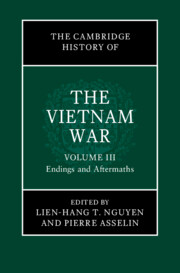Book contents
- The Cambridge History of the Vietnam War
- The Cambridge History of the Vietnam War
- The Cambridge History of the Vietnam War
- Copyright page
- Contents
- Figures
- Maps
- Contributors to Volume III
- General Introduction
- Introduction
- Part I The Late Vietnam War
- 1 Nixon’s War
- 2 US Military Strategy in the Nixon Era
- 3 The US Congress and the Vietnam War
- 4 US Antiwar Sentiment and International Relationships in the Late Vietnam War
- 5 Saigon War Politics, 1968–1975
- 6 Hanoi’s Politburo at War, 1969–1975
- 7 The Vietnam War and the Regional Context
- 8 Moscow, Beijing, and Détente
- 9 The Easter Offensive and the Second Air War
- 10 The Second Civil War, 1973–1975
- 11 Cambodia at War
- 12 Laos at War
- Part II The Postwar Era
- Part III Legacies
- Index
2 - US Military Strategy in the Nixon Era
from Part I - The Late Vietnam War
Published online by Cambridge University Press: 02 January 2025
- The Cambridge History of the Vietnam War
- The Cambridge History of the Vietnam War
- The Cambridge History of the Vietnam War
- Copyright page
- Contents
- Figures
- Maps
- Contributors to Volume III
- General Introduction
- Introduction
- Part I The Late Vietnam War
- 1 Nixon’s War
- 2 US Military Strategy in the Nixon Era
- 3 The US Congress and the Vietnam War
- 4 US Antiwar Sentiment and International Relationships in the Late Vietnam War
- 5 Saigon War Politics, 1968–1975
- 6 Hanoi’s Politburo at War, 1969–1975
- 7 The Vietnam War and the Regional Context
- 8 Moscow, Beijing, and Détente
- 9 The Easter Offensive and the Second Air War
- 10 The Second Civil War, 1973–1975
- 11 Cambodia at War
- 12 Laos at War
- Part II The Postwar Era
- Part III Legacies
- Index
Summary
From a strategic standpoint, the final years of the American war in Vietnam highlighted a persistent uncertainty over how the conflict would end. Both civil and military leaders wrestled with confusing estimates on the war’s progress. These uncertainties mattered because they influenced the timing of and ways in which US forces withdrew from a war that would not end once the Americans had departed. Despite arguments that General Creighton Abrams had fought a “better war” in Vietnam leading to a military victory, a sense of strategic stalemate hung over these final years. Problems remained in assessing the political aspects of pacification, the staying power of the South Vietnamese armed forces once American troops departed, and the longterm viability of the Saigon regime. By early 1969, Abrams also had to confront political decisions leading to the first withdrawal of US troops, decisions that would pit him against the Nixon administration and bring to the surface grave civil–military tensions. Despite years of effort, a key question remained unanswered as these withdrawals began – how stable would South Vietnam be once Americans departed? Ultimately, these final years left the Americans no closer to answering the question of whether they would achieve “victory” in Vietnam.
- Type
- Chapter
- Information
- The Cambridge History of the Vietnam War , pp. 45 - 71Publisher: Cambridge University PressPrint publication year: 2024

